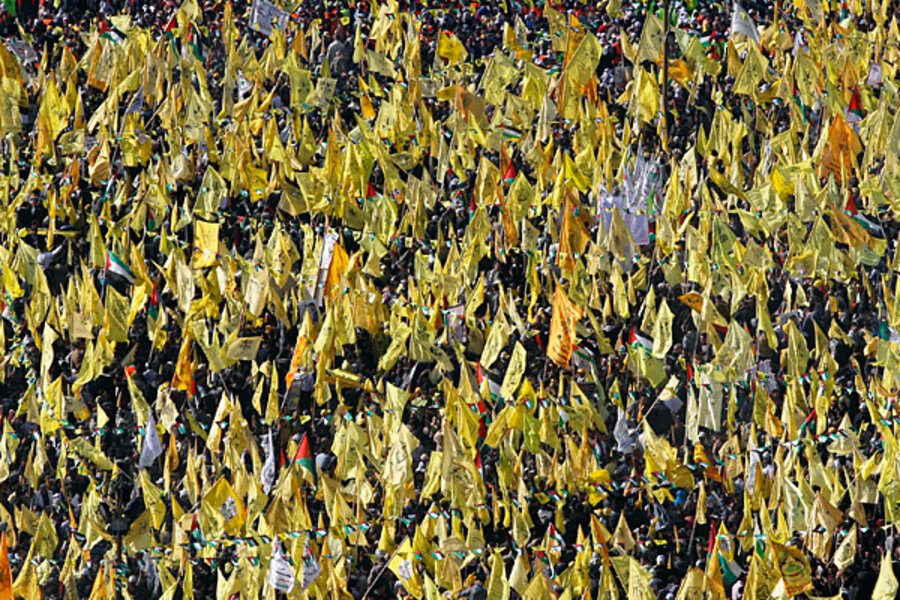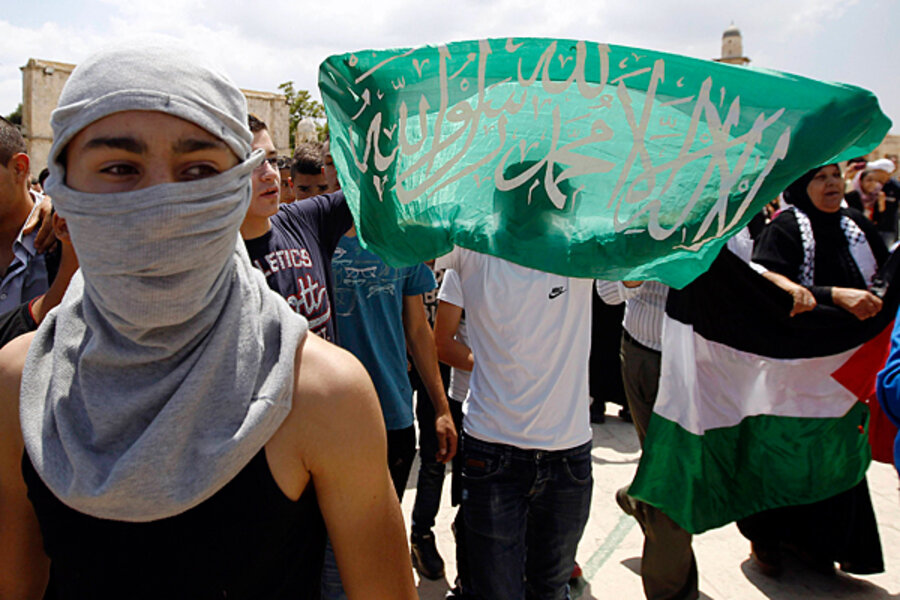Briefing: Palestinian factions agree to reconcile
Loading...
| Gaza City, Gaza
After Egyptian-mediated talks in Cairo, the two main Palestinian factions announced yesterday that they would form a new unity government within three months, which would end the six-year split between them. But previous such agreements have run into obstacles that prevented their implementation. Here's a look at the challenges involved in Palestinian reconciliation.
Who are the two main Palestinian factions?
The two main factions are Fatah and Hamas.
Fatah was founded by Palestinian leader Yasser Arafat, who died in 2004. It is a secular party and dominates the Palestine Liberation Organization (PLO), which is the official representative of the Palestinian people. Fatah also leads the Palestinian Authority, the interim government established by the 1993 Oslo Accords as a preliminary step toward statehood.
Hamas is an Islamist movement that is an offshoot of Egypt’s Muslim Brotherhood. It was founded in 1987 during the first intifada and opposed the Oslo Accords on the grounds that historic Palestine is a Muslim endowment, or waqf, that no Muslim has the right to abandon or renounce – in whole or in part.
It rose to prominence in 2006 Palestinian elections as an alternative to Fatah, which was widely seen as corrupt and unable to deliver a peace deal with the Israelis despite more than a decade of negotiations. Hamas, which is designated a terrorist group by the US, Israel, and Europe, surprised and dismayed many by winning 44 percent of the vote to Fatah’s 41 percent.
Why is the Palestinian house divided?
The 2006 elections resulted in a unity government between Fatah and Hamas, but a year later the two rivals engaged in violent street battles in Gaza.
Hamas ultimately ousted Fatah from Gaza in June 2007 and has since governed the coastal territory and its 1.7 million residents, while the Fatah-dominated Palestinian Authority has run the West Bank, home to 2 to 2.5 million Palestinians. The PA has some involvement in overseeing health and education in Gaza, but in general the two governments function independently.
Some 90 percent of Palestinians are in favor of reconciliation, according to a March poll by the Jerusalem Media and Communications Centre, but 20 to 29 percent see Fatah and Hamas, respectively, as blocking it.
Hamas leader Khaled Meshaal is seen by many as genuinely seeking reconciliation. But the Hamas tent includes a wide range of views and agendas. In addition to the political bureau that Mr. Meshaal runs from Qatar and Egypt, there are various Hamas structures in Gaza, including local councils, the government, an armed wing known as the al-Qassam Brigades, and a powerful Shura council. Meshaal faces opposition from Hamas leaders in Gaza who don’t want PA President Mahmoud Abbas to undermine their authority in the tiny coastal territory.
Furthermore, many in Hamas see regional trends moving in their favor. Political scientist Mkhaimer Abu Saada of Gaza’s Al Azhar University points out that two years ago Islamists were isolated and feared by the West, but now the tables have turned.
“If the West, the US, and Europeans is reaching out to Islamists in Tunisia, Egypt, Libya, and Syria, why are they not going to reach out to Hamas? Hamas is part of the camp,” he says. “That is another reason why Hamas is not in a hurry for reconciliation.”
On the contrary, he adds, it is President Abbas whose “time is running out,” due to Israeli settlement expansion that is eating away at the West Bank – and Mr. Abbas’s credibility.
What would be the benefits of reconciliation?
Reconciling the Hamas-Fatah divide would enable the Palestinian people to speak with one voice, and ensure that any peace deal with Israel – if such a deal could be reached despite Hamas's involvement in government – could be enforced not only in the West Bank but in Gaza as well.
It would also open the way for new elections and allow Palestinians to weigh in on their respective leadership’s performance over the past seven years. Many Palestinians in Gaza are fed up with Hamas, which has gone from being an ideological leader of the “resistance” against Israel to a necessarily more bureaucratic organization. Once a strong advocate of ending corruption in the PA, Hamas itself is increasingly accused of corruption, especially as officials benefit from the movement’s real estate projects, taxes on cross-border smuggling tunnels, and other economic ventures. It has also introduced a number of unpopular social restrictions including a ban on “inappropriate” haircuts.
Palestinians in the West Bank are also dissatisfied with their leaders; PA Prime Minister Salam Fayyad recently announced his resignation after months of unpopular economic policies and delayed paychecks for public employees led to strikes and protests.
Still, if elections were held today, Fatah would gain about 43 percent of the seats compared to 21 percent for Hamas, according to a March poll by the Jerusalem Media and Communications Centre.
What are the challenges to getting there?
Despite overwhelming public support for reconciliation, there is widespread pessimism that the Hamas-Fatah rift will be bridged anytime soon, in part because both sides are seen as reluctant to give up power and influence.
“I believe that reconciliation would weaken Hamas,” says Ramadan, a young, smartly dressed Hamas supporter in Gaza’s Jabaliya refugee camp. “Once Hamas will divide authority with the PA, there will be a lot of restrictions on al-Qassam training and on Hamas supporters. Hamas will not be allowed to react to Israeli violence in Gaza.”
Hamas has an estimated 42,000 security employees, including some 15,000 in its armed wing, the al-Qassam Brigades, says Prof. Abu Saada. Meanwhile the PA has continued to pay most of the 50,000 security personnel it had in Gaza at the time of the 2007 split, when PA President Mahmoud Abbas ordered them to stay home in an attempt to undermine Hamas’s ability to govern. Reconciliation will likely involve tough compromises on both sides over which security forces would represent the new unity government.
Hamas is reluctant to cede its control of security in Gaza, especially without getting any role in West Bank security, where PA forces currently work closely with Israel to round up Hamas members.
In addition, Hamas is sidelined in the PLO, and is seeking a more equitable share of power there.
But Fatah, not unlike Hamas, is reluctant to share the authority it currently enjoys, says former PA spokesman Ghassan Khatib.
In addition, there could be serious financial consequences for reconciliation. The US is the single largest donor to the cash-strapped PA and has threatened to cut funding if Hamas is brought back into the fold without recognizing Israel’s right to exist, renouncing its armed struggle against its Jewish neighbors, and recognizing previous agreements made with the PA – including the Oslo Accords.
“The PA led by Fatah is dependent on aid from the outside world,” says Mr. Khatib. “The international community, and particularly the United States, is warning against reconciliation so they feel that they might risk part of the aid.”
In addition to such substantive issues, the reconciliation talks have been poorly managed, said Ghazi Hamad, deputy foreign minister of the Hamas government, in an interview last month.
“Since five years we did not move one step,” said Mr. Hamad. “We have agreements, we have negotiations, we have meetings, but on the ground it’s zero, big zero. Really, this is the tragedy of reconciliation.”









